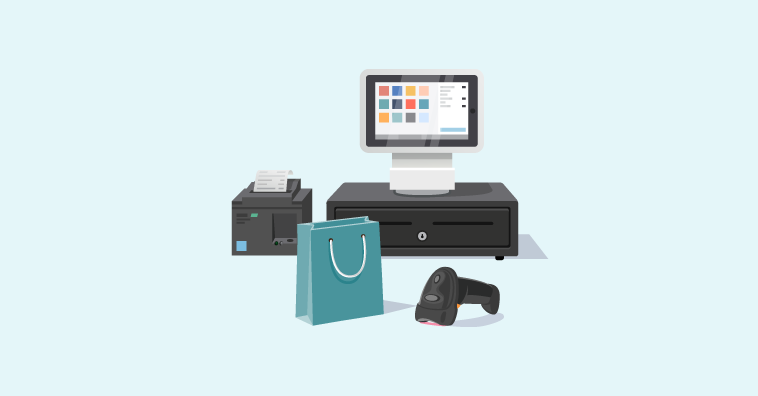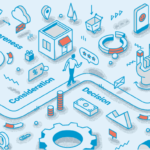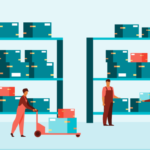It’s the moment you went into business to create – when customers find the product they are looking for or discover something they didn’t even know they needed. Of course, a moment like this deserves an official-sounding name. When the customer brings an item to your counter or adds it to their online shopping cart, they are at the point of sale (POS). This is the moment they become a customer for the first time or cement their loyalty with repeat purchases. It’s the moment they exchange money for your products. And it’s a moment you can optimize when you have the right point-of-sale system in place.
What is a retail POS system?
A POS system is the hardware and software that provides businesses with the ability to conduct sales through the acceptance of payment. The traditional definition of point of sale focuses on the transactional aspect – ringing up a customer’s purchase and processing the payment. That’s still a key element of point of sale, but modern retail POS systems go beyond the old-school cash register to handle payments in-person, online, and via mobile devices. The best retail POS systems also provide software solutions that help retailers manage their inventory, track sales, and make data-informed business decisions.
4 reasons retailers need a POS system
As retailers compete in a dynamic and challenging industry, they share the same goals of attracting and retaining customers, driving increased purchase rates, and selling products at margins that enable the business to succeed and grow. To achieve these strategic goals, the retailer’s POS system becomes an essential and differentiating tool in four core areas.
1. Deliver a purchase experience that meets customer expectations.
The purchase is still the centerpiece of POS system functionality. As today’s consumers shift seamlessly from online to offline shopping and back again, they expect the process to be simple when they’re ready to purchase. Along with providing omnichannel ease that gives customers the ability to buy in-store or online, your POS system should enable you to process payments via mobile devices from anywhere in the store or the parking lot as you offer convenient pick-up and buy-online-pick-up-in-store options.
In addition to giving customers options on where they purchase, your POS system must offer a range of payment choices. With contactless, digital payment capabilities, like tap-to-pay credit and debit cards, digital wallets, and mobile payments, replacing cash as the most-used payment option, half of customers won’t complete a purchase if their preferred payment method isn’t available.
An increasing number of customers are also looking for the flexibility of buy-now-pay-later (BNPL) payment options. As of 2021, 56 percent of consumers report using a BNPL option, which is a significant jump from 38 percent in 2020. To make the most of the BNPL trend, look for a POS system that offers capabilities to enable and streamline in-house accounts, payments on account, recurring billing, and finance charges.
Related: Retail Payment Preferences: What Today’s Customers Expect
2. Achieve inventory efficiencies that drive business growth.
The best POS systems offer integrated, end-to-end inventory management that provides valuable insights into your business and efficiencies that can give you back time in your day. With most retailers operating across brick-and-mortar and e-commerce channels, having a centralized, real-time view of inventory is essential. But you should also expect your POS system to go beyond basic in-stock inventory tracking. It should also help you:
- Track multiple style attributes: For retailers who change inventory from season to season, look for a POS system that provides the ability to manage inventory at the SKU level. This means detailed inventory tracking across sizes, colors, and styles.
- Streamline specialized inventory management: Most stores have specialized inventory needs. Rather than tackling them manually, choose a POS system that offers capabilities to fit your business. For example, wine and liquor retailers need to be able to track inventory by the case or single bottles, while fabric stores must track items by the yard or short bolts.
- Automate complex inventory tasks: Look for functionality that enables you to upload and add multiple items at the same time, set low-stock alerts and re-order triggers, print custom barcode labels, and track serialized inventory.
Optimizing the inventory management capabilities within your POS system helps ensure that popular products are in-stock and provides early indicators of underperforming items. With comprehensive and accessible inventory data at your fingertips, you can create accurate forecasts, make informed buying decisions, and maintain a healthy cash flow.
Related: 3 Secrets Behind Effective Inventory Management
3. Create and implement strategic plans.
Being able to turn your data into insights and actions is imperative in today’s hyper-competitive retail market. Your POS system should serve as a data hub bringing together sales, inventory, and customer data points so that you’re able to create the reports you need to run and grow your business.
From automated daily, weekly, and monthly sales reports through inventory on-hand, best-seller, and low-stock reports, your POS system brings together data to help you make decisions and identify trends. Having the right reports keeps your fingers on the pulse of your business, both in real-time and year-over-year. Along with automated reports, look for a POS system that provides the flexibility to track and analyze customer data points so you can understand buying behaviors, drive increased loyalty, and maximize sales.
Related: Optimize Your Data: The 5 Reports Every Retailer Needs
4. Provide a memorable and differentiating customer experience.
One of the best ways to stand out from the competition is by providing a consistently excellent customer experience. Seventy-four percent of consumers are somewhat or highly likely to base their purchase decisions on the shopping experience rather than price and product selection. Your POS system is at the heart of delivering a customer experience that sparks purchases and inspires loyalty.
With an integrated POS system, you can capture customer profile data – and make it easily accessible for frontline associates to personalize customer interactions with recommendations based on past purchases or a timely heads-up about an upcoming sale. Look for a POS system that enables you to not only collect basics like contact info and birthday but also gives you the flexibility to customize customer relationship management (CRM) with fields to add style, color, or brand preferences, shipping requests, and other helpful info.
The best POS systems can also help you design and implement personalized marketing campaigns and valued loyalty programs. Plus, depending on the type of products you offer, your POS system can also help you add value to your customer experience by offering and managing convenient service and repair options for your customers.
Related: 8 Ways to Put the Wow in Your Point-of-Sale Experience
POSIM is a point-of-sale and inventory management system that’s designed to help retailers deliver the experiences customers expect while also providing the integrated e-commerce, inventory management, and reporting capabilities retailers need to run and expand their business. Find out which POSIM plan is right for your business. View our plans today.












